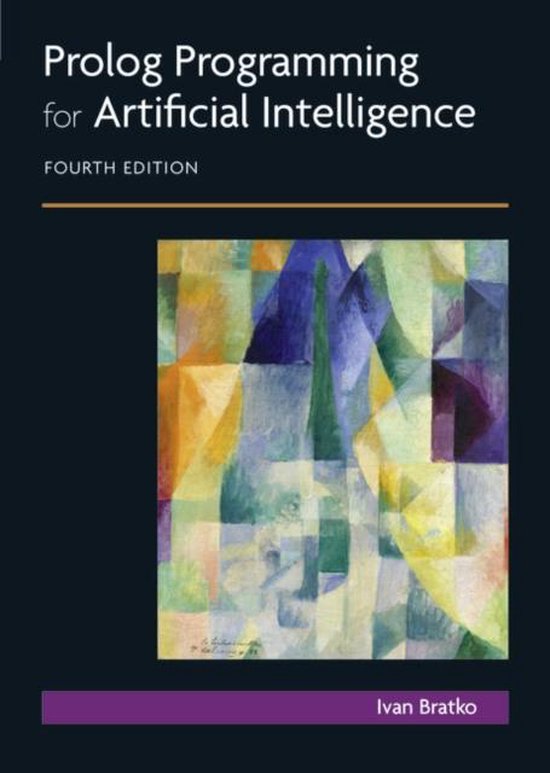
| Taal: | en |
| Bindwijze: | Paperback |
| Oorspronkelijke releasedatum: | 24 augustus 2011 |
| Aantal pagina's: | 673 |
| Illustraties: | Nee |
| Hoofdauteur: | Ivan Bratko |
| Hoofdauteur: | Ivan Bratko |
| Originele titel: | ICSS.Bratko:Prolog Programming f_p3 |
| Editie: | 4 |
| Extra groot lettertype: | Nee |
| Product breedte: | 171 mm |
| Product hoogte: | 36 mm |
| Product lengte: | 238 mm |
| Studieboek: | Ja |
| Verpakking breedte: | 172 mm |
| Verpakking hoogte: | 41 mm |
| Verpakking lengte: | 240 mm |
| Verpakkingsgewicht: | 1168 g |
| Editie: | 4 |
| Extra groot lettertype: | Nee |
| Product breedte: | 171 mm |
| Product hoogte: | 36 mm |
| Product lengte: | 238 mm |
| Studieboek: | Ja |
| Verpakking breedte: | 172 mm |
| Verpakking hoogte: | 41 mm |
| Verpakking lengte: | 240 mm |
| Verpakkingsgewicht: | 1168 g |
The fourth edition of this best-selling guide to Prolog and Artificial Intelligence has been updated to include key developments in the field while retaining its lucid approach to these topics. Divided into two parts, the first part of the book introduces the programming language Prolog, while the second part teaches Artificial Intelligence using Prolog as a tool for the implementation of AI techniques.
Prolog has its roots in logic; however the main aim of this book is to teach Prolog as a practical programming tool. This text therefore concentrates on the art of using the basic mechanisms of Prolog to solve interesting problems. The fourth edition has been fully revised and extended to provide an even greater range of applications, which further enhance its value as a self-contained guide to Prolog, AI or AI Programming for students and professional programmers alike.
Features:
· Combined approach to Prolog and AI allows flexibility for learning and teaching
· Provides a thorough representation of AI, emphasizing practical techniques and Prolog implementations
· Prolog programs in the book are available for download from the book's companion website at www.pearsoned.co.uk/bratko. Lecturers visiting the website have access to PowerPoint slides.
New for this edition:
· Coverage of constraint logic programming (CLP) is extended and now introduced earlier in the book, in the Prolog part
· Most of the existing chapters on AI techniques have been systematically improved and updated
· Coverage of planning methods is deepened in a new chapter that includes implementations of partial order planning and the GRAPHPLAN approach
· The treatment of search methods now includes an RTA* program (real-time A* search)
· The chapter on meta-programming (now chapter 25) is extended by the addition of sections on abductivereasoning, query-the-user interpreter, and a sketch of CLP interpreter, all implemented as Prolog meta-interpreters
· Programming examples are refreshed throughout the book, making them more interesting and practical. One such example introduces semantic reasoning with the well-known lexical database WordNet®
Author:
Professor Ivan Bratko leads the AI Lab in the Faculty of Computer and Information Science at the University of Ljubljana. He has taught Prolog worldwide, as well as applied Prolog in medical expert systems, robot programming, qualitative modelling and computer chess research.
The fourth edition of this best-selling guide to Prolog and Artificial Intelligence has been updated to include key developments in the field while retaining its lucid approach to these topics. New and extended topics include Constraint Logic Programming, abductive reasoning and partial order planning.
Divided into two parts, the first part of the book introduces the programming language Prolog, while the second part teaches Artificial Intelligence using Prolog as a tool for the implementation of AI techniques.
This textbook is meant to teach Prolog as a practical programming tool and so it concentrates on the art of using the basic mechanisms of Prolog to solve interesting problems. The fourth edition has been fully revised and extended to provide an even greater range of applications, making it a self-contained guide to Prolog, AI or AI Programming for students and professional programmers.